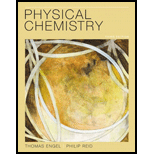
(a)
Interpretation: The pressure that is requiredto lower the melting temperature of ice by 4.0°C needs to be determined if at 1 atm, ice melts at 273.15 K,
Concept Introduction:All substances can mainly exist in three phases; solid, liquid and gas. These three phases can convert into each other by the application of temperature and pressure such as heating of solid leads to the conversion to liquid and then gaseous
Similarly, the gases can be compressed at high pressure to liquefy. The enthalpy change during the fusion of solid to liquid is called as enthalpy of fusion that is denoted as
(b)
Interpretation: The pressure exerted at the interface of the skate and the ice needs to be determined if the width of the skate that is in contact with the ice gets reduced to
Concept Introduction: All substances can mainly exist in three phases; solid, liquid and gas. These three phases can convert into each other by the application of temperature and pressure such as heating of solid leads to the conversion to liquid and then gaseous state of matter.
Similarly, the gases can be compressed at high pressure to liquefy. The enthalpy change during the fusion of solid to liquid is called as enthalpy of fusion that is denoted as
(c)
Interpretation: The melting point of ice under the pressure calculated in part (b) needs to be determined.
Concept Introduction: All substances can mainly exist in three phases; solid, liquid and gas. These three phases can convert into each other by the application of temperature and pressure such as heating of solid leads to the conversion to liquid and then gaseous state of matter.
Similarly, the gases can be compressed at high pressure to liquefy. The enthalpy change during the fusion of solid to liquid is called as enthalpy of fusion that is denoted as
(d)
Interpretation: Whether the melting of ice takes place at the ice-skate interface if the temperature of the ice is -4.0°C or not needs to be explained.
Concept Introduction: All substances can mainly exist in three phases; solid, liquid and gas. These three phases can convert into each other by the application of temperature and pressure such as heating of solid leads to the conversion to liquid and then gaseous state of matter.
Similarly, the gases can be compressed at high pressure to liquefy. The enthalpy change during the fusion of solid to liquid is called as enthalpy of fusion that is denoted as
Want to see the full answer?
Check out a sample textbook solution
Chapter 8 Solutions
Physical Chemistry Plus Mastering Chemistry With Etext -- Access Card Package (3rd Edition) (engel Physical Chemistry Series)
- In the decomposition reaction in solution B → C, only species C absorbs UV radiation, but neither B nor the solvent absorbs. If we call At the absorbance measured at any time, A0 the absorbance at the beginning of the reaction, and A∞ the absorbance at the end of the reaction, which of the expressions is valid? We assume that Beer's law is fulfilled.arrow_forward> You are trying to decide if there is a single reagent you can add that will make the following synthesis possible without any other major side products: 1. ☑ CI 2. H3O+ O Draw the missing reagent X you think will make this synthesis work in the drawing area below. If there is no reagent that will make your desired product in good yield or without complications, just check the box under the drawing area and leave it blank. Click and drag to start drawing a structure. Explanation Check ? DO 18 Ar B © 2025 McGraw Hill LLC. All Rights Reserved. Terms of Use | Privacy Center | Accessibilityarrow_forwardDon't use ai to answer I will report you answerarrow_forward
- Consider a solution of 0.00304 moles of 4-nitrobenzoic acid (pKa = 3.442) dissolved in 25 mL water and titrated with 0.0991 M NaOH. Calculate the pH at the equivalence pointarrow_forwardWhat is the name of the following compound? SiMe3arrow_forwardK Draw the starting structure that would lead to the major product shown under the provided conditions. Drawing 1. NaNH2 2. PhCH2Br 4 57°F Sunny Q Searcharrow_forward
- 7 Draw the starting alkyl bromide that would produce this alkyne under these conditions. F Drawing 1. NaNH2, A 2. H3O+ £ 4 Temps to rise Tomorrow Q Search H2arrow_forward7 Comment on the general features of the predicted (extremely simplified) ¹H- NMR spectrum of lycopene that is provided below. 00 6 57 PPM 3 2 1 0arrow_forwardIndicate the compound formula: dimethyl iodide (propyl) sulfonium.arrow_forward
 ChemistryChemistryISBN:9781305957404Author:Steven S. Zumdahl, Susan A. Zumdahl, Donald J. DeCostePublisher:Cengage Learning
ChemistryChemistryISBN:9781305957404Author:Steven S. Zumdahl, Susan A. Zumdahl, Donald J. DeCostePublisher:Cengage Learning ChemistryChemistryISBN:9781259911156Author:Raymond Chang Dr., Jason Overby ProfessorPublisher:McGraw-Hill Education
ChemistryChemistryISBN:9781259911156Author:Raymond Chang Dr., Jason Overby ProfessorPublisher:McGraw-Hill Education Principles of Instrumental AnalysisChemistryISBN:9781305577213Author:Douglas A. Skoog, F. James Holler, Stanley R. CrouchPublisher:Cengage Learning
Principles of Instrumental AnalysisChemistryISBN:9781305577213Author:Douglas A. Skoog, F. James Holler, Stanley R. CrouchPublisher:Cengage Learning Organic ChemistryChemistryISBN:9780078021558Author:Janice Gorzynski Smith Dr.Publisher:McGraw-Hill Education
Organic ChemistryChemistryISBN:9780078021558Author:Janice Gorzynski Smith Dr.Publisher:McGraw-Hill Education Chemistry: Principles and ReactionsChemistryISBN:9781305079373Author:William L. Masterton, Cecile N. HurleyPublisher:Cengage Learning
Chemistry: Principles and ReactionsChemistryISBN:9781305079373Author:William L. Masterton, Cecile N. HurleyPublisher:Cengage Learning Elementary Principles of Chemical Processes, Bind...ChemistryISBN:9781118431221Author:Richard M. Felder, Ronald W. Rousseau, Lisa G. BullardPublisher:WILEY
Elementary Principles of Chemical Processes, Bind...ChemistryISBN:9781118431221Author:Richard M. Felder, Ronald W. Rousseau, Lisa G. BullardPublisher:WILEY





